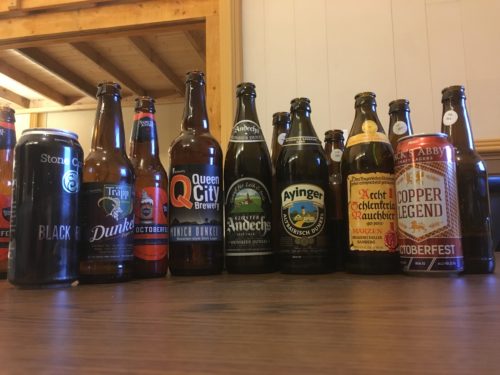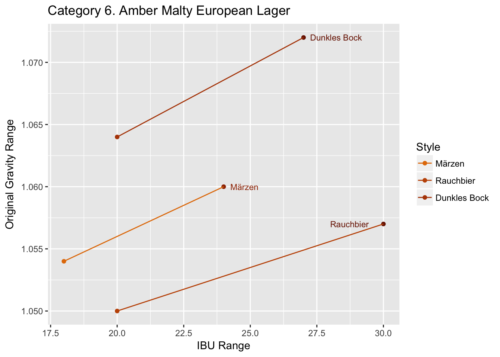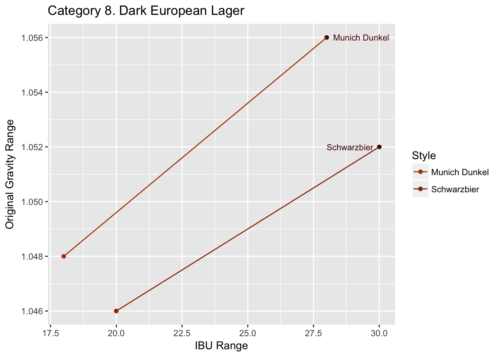BJCP Study Group: Categories 6 & 8
¶ by Rob FrieselOur study group’s thirteenth session, and a night over-loaded with two categories and a small club meeting. And perhaps it was that pre-game of an informal club meeting that helped, but we had pretty good attendance, and all but one of the styles represented.
Categories 6 (Amber Malty European Lager) & 8 (Dark European Lager)
It seemed reasonable to have these two categories brought together for the study session. Looking over the guidelines for each, they’re both on the darker side (from amber to very-nearly-black) and, although Category 8 doesn’t explicitly say so, the constituent styles tend toward a malty balance. They’re also all German-heritage beers. Broadly speaking, they’re moderate strength beers (flirting with both sides of the 5-6% range, though Dunkles Bock can go higher). Bitterness should be present to balance, but hops shouldn’t be a major contributor to aroma or flavor. Malts should drive the sensory experience, with “bready” and “toasty” largely describing the Category 6 beers (leaving room for the oddball 6B. Rauchbier), and “restrained roast” being more apt for Category 8. All of them should be fermented with lager yeasts, and have a clean fermentation profile.
| 6A. Märzen | 6B. Rauchbier | 6C. Dunkles Bock |
|---|---|---|
| 18 – 24 IBU | 20 – 30 IBU | 20 – 27 IBU |
| 1.054 – 1.060 O.G. | 1.050 – 1.057 O.G. | 1.064 – 1.072 O.G. |
| 1.010 – 1.014 F.G. | 1.012 – 1.016 F.G. | 1.013 – 1.019 F.G. |
| 5.8 – 6.3% ABV | 4.8 – 6.0% ABV | 6.3 – 7.2% ABV |
| 8A. Munich Dunkel | 8B. Schwarzbier |
|---|---|
| 18 – 28 IBU | 20 – 30 IBU |
| 1.048 – 1.056 O.G. | 1.046 – 1.052 O.G. |
| 1.010 – 1.016 F.G. | 1.010 – 1.016 F.G. |
| 4.5 – 5.6% ABV | 4.4 – 5.4% ABV |
We were well-stocked for the night, including multiple 8A samples for “the Dunkel Challenge” — though we were missing the 6C. Dunkles Bock.
- 6A. Märzen. Jack’s Abby Copper Legend. Judged; structured tasting. Group scores were mostly in the high-30s to low-40s. 1 We talked through the malt profile quite a bit, and tried to breakdown a way to distinguish between “toasty” and “bready”. This particular beer seemed to be more of the former, though the latter flavor increased as it warmed (especially if you held it in your mouth). General consensus that it was a little bit light in color, but otherwise a very pleasing beer and an excellent example of the style.
- 6A. Märzen. Sam Adam’s Octoberfest. We performed a semi-structured tasting, but no scoresheet. This was mostly to do a back-to-back comparison of two beers (supposedly) in the same style. Of particular note was a light caramel note that ran throughout (and was even called out on the label!) which was decidedly off-style. Not a bad beer, but we mostly spit-balled this as a low-30s score due to the caramel.
- 8B. Schwarzbier. Stone Corral Black Beer. Judged; structured tasting. (We wanted to make sure that we did a scoresheet for at least one beer from both of the categories.) Group member scores were mostly in the high-30s, clustered between 36-39, with maybe one or two exceptions. We talked at length about the differences between perceptions of roast vs. burnt. We also discussed how having bitterness on the high side of a beer that’s otherwise malt-forward could be mis-read as astringency. There was some general agreement that this beer was probably flirting with the upper-end of the bitterness range for the style, and might even have gone over a bit; it was still a pleasing beer, and balanced, but it was noteworthy.
- 8A. Munich Dunkel. Ayinger Altbairisch Dunkel. DUNKEL CHALLENGE! Not judged; not a structured tasting. We suspected the bottle might have been old. It hit a lot of the marks along the style guidelines, but seemed to fall flat — subdued where it should have been rich. Would love to get hands on a fresh one.
- 8A. Munich Dunkel. Queen City Brewery Munich Dunkel. DUNKEL CHALLENGE! Not judged; not a structured tasting. Flavors melded well. Probably the best one of the challenge.
8A. Munich Dunkel10B. Dunkles Weissbier. Andechser Weissbier Dunkel. DUNKEL CHALLENGE! Not judged; not a structured tasting. “Well, it said Dunkel!” our evening’s coordinator laughed. Not in-style, but we made the most of it for a fun comparison. After two lagers, the big banana-and-clove ester qualities of the wheat beer really stood out.- 8A. Munich Dunkel. von Trapp Dunkel Lager. DUNKEL CHALLENGE! Not judged; not a structured tasting. Seemed too grainy — and the grainy quality seemed to enhance the bitterness, making it seem somewhat off-style. I’ve had this before and really enjoyed it, so I wondered what was up with this batch.
- 6B. Rauchbier. Aecht Schlenkerla Rauchbier (Märzen). Not a structured tasting, so no scoresheets. Fascinating discussion around this beer though. First off, the club had just (the Saturday before) brewed a Märzen-based Rauchbier, so several members present had just such a beer fermenting away in their basements etc. This brought up a point that had been raised during the club brew, that — though listed as a style in the guidelines — a Rauchbier really refers to an ingredient choice. 2 In turn, this led to the discussion about this particular style being another case of “allowing for variation” in the style. That being said, the 6B style refers specifically to a Märzen-based formulation that uses a high-proportion of smoked malt. And although the 6B guidelines explicitly say to “allow for variation”, they also say that smoked beers based around other styles should be entered in competition as 32A. Classic Style Smoked Beers. At this point we circled back onto the discussion of 6B specifically, focusing in on the Märzen aspect, and wondering: if the smoked character really is that strong (as the Schlenkerla is) then can you even detect the Märzen underneath? How can you evaluate the underlying Märzen if you can’t discern it out from under all the smoke character?
- Bonus beers. Out came the homebrew examples! We tasted two 8B beers, an 8A, and a 6A — all left over from the 2017 Noonan competition. (I’ll admit it though, palate fatigue had definitely set in by then.)
Takeaways
The themes and broad observations from the night:
- Maturing the scoring. It would be interesting to track everyone’s scores for every beer over the course of every session. I believe that we’re all maturing as tasters and judges. The scores are naturally clustering around the same spots, without much deviation. I don’t believe this was the case when we started back in May.
- Spend time with the “odd-ball” styles. The discussion around the Rauchbier was a fascinating one, and it raised a lot of interesting questions. It is worth spending time with the guidelines, but also worth really poking at them. Wonder why a style is the way it is. How did it get to be that way? What shaped it? What causes a version of the style to veer off course?
- Watch out for those extremes. The Black Beer drove this one home. I couldn’t find a reliable source for its IBUs, but I suspect that it’s on the high side (or even over) for the style. It’s probably a good idea to seek out beers like this to see what effects it has on the overall profile. Is it still balanced? What would it need to be balanced? Does it amplify any other qualities of the beer? Does it drown anything else out?
- Though one person gave it a 45, though he admitted that he loved Jack’s Abby in general, and Märzens in particular. Another reason to do these blind![↩]
- Additional background: at first it was being argued that it was “a technique” but after dissection of that argument, it really comes down to the use of smoked malts in the mash. So if you want to call it “a technique” then what you really mean is “a malting technique”.[↩]



Leave a Reply